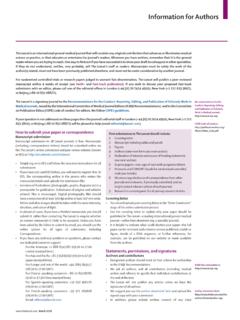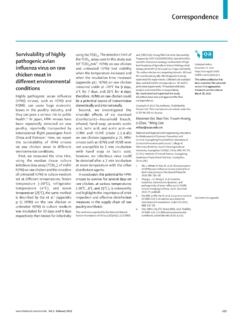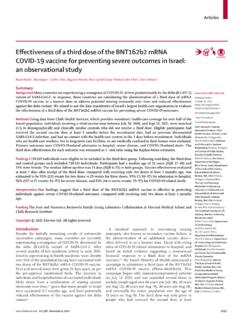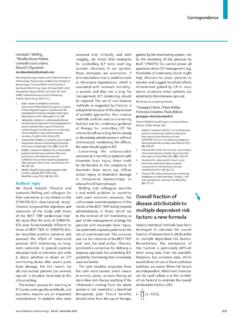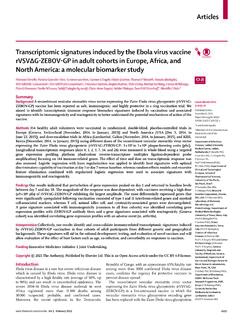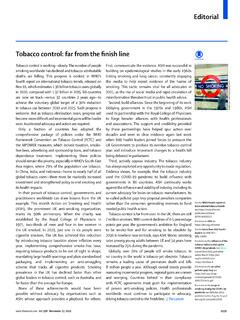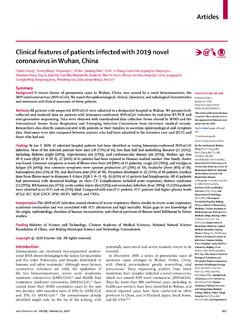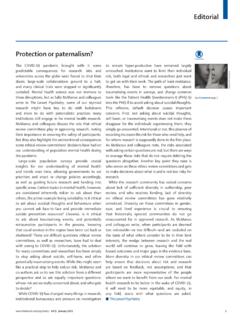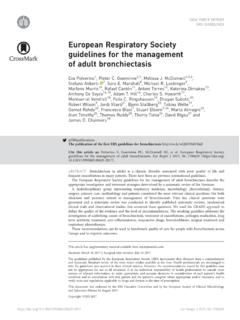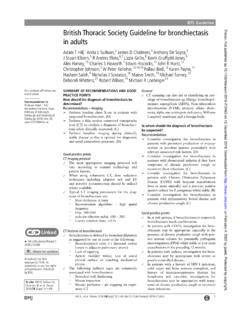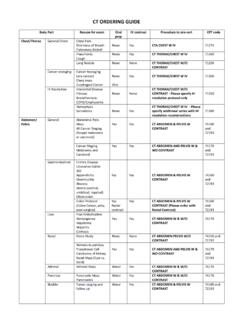Transcription of Prevalence and subtyping of biofilms present in ...
1 Vol 3 March 2022 e215 ArticlesPrevalence and subtyping of biofilms present in bronchoalveolar lavage from children with protracted bacterial bronchitis or non-cystic fibrosis bronchiectasis : a cross-sectional studyRobyn L Marsh, Michael J Binks, Heidi C Smith-Vaughan, Maxine Janka, Sharon Clark, Peter Richmond, Anne B Chang, Ruth B ThorntonSummaryBackground Lower airway biofilms are hypothesised to contribute to poor treatment outcomes among children with chronic lung disease; however, data are scarce. We aimed to determine the presence and Prevalence of biofilm in bronchoalveolar lavage from children with protracted bacterial bronchitis (PBB) or bronchiectasis ; whether biofilm was associated with signs of lower airway infection; and whether biofilms were consistent with an upper or lower airway In this cross-sectional study, fluorescent microscopy techniques were used to detect biofilm in archived bronchoalveolar lavage specimens from a paediatric cohort (age <18 years) with PBB or bronchiectasis who were prospectively recruited to observational studies of chronic cough at Royal Children s Hospital (Brisbane, Australia) or Royal Darwin Hospital (Darwin, Australia).
2 Children with cystic fibrosis were excluded. Lower airway infection was defined as bronchoalveolar lavage neutrophil percentage of 15% or more, or a culture of a bacterial pathogen at 10 colony-forming units per mL or more, or both. biofilms were subtyped as either of lower airway origin (unrelated to squamous epithelial cells) or of upper airway origin (observed in close association with squamous epithelial cells). Bronchoalveolar lavages were considered contaminated with upper airway secretions if the squamous cell proportion was more than ten cells per 1000 nucleated cells (>1%). Primary outcomes were the Prevalence of each biofilm subtype among children with PBB compared with children with bronchiectasis . Secondary outcomes were the Prevalence of each biofilm subtype among children with signs of lower airway infection compared to children Biofilm testing was performed on 144 bronchoalveolar lavage specimens collected between Jan 1, 2011, and Dec 16, 2014, and preserved at 80 C before biofilm testing (69 children with PBB from Brisbane and 75 children with bronchiectasis from Darwin).
3 The Prevalence of lower airway biofilms (unrelated to squamous epithelial cells) was similar among the children with PBB (25 [36%] of 69) and children with bronchiectasis (31 [41%] of 75; odds ratio [OR] 1 24, 95% CI 0 63 2 43), but higher among children with signs of lower airway infection (46 [48%] of 95) than children without (eight [19%] of 43; OR 4 11, 95% CI 1 73 9 78), irrespective of the underlying diagnosis. By contrast, upper airway biofilms (associated with squamous epithelial cells) were more prevalent among children with bronchiectasis (32 [43%] of 75) than children with PBB (16 [23%] of 69; OR 2 47, 95% CI 1 20 5 08) and were unrelated to lower airway infection. Upper airway contamination was uncommon (eight [11%] of 71) and was not evident in 23 (79%) of 29 bronchoalveolar lavages that were positive for upper airway Lower airway biofilms are prevalent, but not ubiquitous, in bronchoalveolar lavage from children with PBB or bronchiectasis , suggesting anti-biofilm therapies might be beneficial for some children.
4 Detection of upper airway biofilms in bronchoalveolar lavage that did not have signs of contamination suggests that microaspiration might be important in some children. Specimen quality measures are recommended for future studies to account for the presence of upper airway Financial Markets for Children Project Grant, National Health and Medical Research Council of Australia, Rebecca L Cooper Medical Research Foundation, Queensland Children s Hospital Foundation, and BrightSpark 2022 The Author(s). Published by Elsevier Ltd. This is an Open Access article under the CC BY-NC-ND Microbe 2022; 3: e215 23 Published Online February 1, 2021 S2666-5247(21)00300-1 Child Health Division, Menzies School of Health Research, Charles Darwin University, Darwin, NT, Australia (R L Marsh PhD, M J Binks PhD, H C Smith-Vaughan PhD, Prof A B Chang PhD); School of Medicine, Griffith University, Gold Coast Campus, Southport, QLD, Australia (H C Smith-Vaughan); Wesfarmers Centre of Vaccines and Infectious Diseases, Telethon Kids Institute, Perth, WA, Australia (M Janka BSc, S Clark BBioMedSc, Prof P Richmond MD, R B Thornton PhD); School of Medicine, Division of Paediatrics (S Clark, Prof P Richmond) and Centre for Child Health Research (R B Thornton) University of Western Australia, Perth, WA, Australia.
5 Department of Respiratory and Sleep Medicine, Queensland Children s Hospital and Australian Centre for Health Services Innovation, Queensland University of Technology, Brisbane, QLD, Australia (Prof A B Chang)Correspondence to: Dr Robyn Marsh, Child Health Division, Menzies School of Health Research, PO Box 41096, Casuarina, NT 0814, Australia bacterial bronchitis (PBB) is common among paediatric populations, affecting up to 40% of children newly referred for specialist management of persistent wet PBB is clinically diagnosed when children have wet cough for more than four weeks, do not have signs of other Articlese216 Vol 3 March 2022causes of cough, and respond to 2 4 weeks of appropriate oral antibiotic Most children with PBB have cough resolution following initial anti biotic treatment.
6 However, up to 44% have more than three episodes in the year following diagnosis and 16% progress to bronchiectasis within 2 bronchiectasis unrelated to cystic fibrosis is an important cause of paediatric morbidity,3 particularly among disadvantaged populations with high burdens of acute respiratory interventions are needed to prevent disease progression and ameliorate the burden (eg, family stresses and health-care costs) among children with PBB or ,5,6 Achieving this outcome requires deeper understanding of the mechanisms underlying the recalcitrance of endobronchial infection in some Current models hypothesise that PBB and bronchiectasis manifest across a pathobiological continuum, whereby failure to clear an initial infection results in persistent endobronchial inflammation that causes tissue Recurrent exacerbations, particularly those requiring hospitalisation.
7 Are asso ciated with further tissue damage and lung function studies have advanced the understanding of the types of bacteria present in the airways of children with PBB or 10 High taxonomic similarity has been shown among the upper and lower airway microbiomes of children with chronic endobronchial infections,8,9 suggesting possible roles for upper respiratory commensal bacteria in the disease processes. One notable example is Prevotella spp that are common upper airway colonisers and that can produce an extended spectrum -lactamase capable of protecting Pseudomonas aeruginosa from ceftazidime is known about phenotypic bacterial persistence mechanisms that might contribute to the recalcitrance of PBB and bronchiectasis . Biofilm is a bacterial persistence mechanism that enables long-term survival in hostile Bacteria in biofilms are protected from host clearance and show markedly reduced susceptibility to antibiotics, even when planktonic cells of the same strain are Biofilm has been observed in sinus, adenoid, and tonsillar tissues14 and is of recognised importance in cystic Although biofilm is hypothesised to contribute to the recalcitrance of PBB in some children,16 there are no data beyond a 1994 study describing three biofilm-positive chronic bronchitis cases (patient age, specimen type, and clinical parameters not reported).
8 17 Among children with bronchiectasis Research in contextEvidence before this studyA biofilm is a bacterial phenotype that is hypothesised to contribute to the variable treatment responses reported for children with protracted bacterial bronchitis (PBB) or bronchiectasis unrelated to cystic fibrosis; however, there are scant data. We searched PubMed, medRxiv, and bioRxiv databases on June 17, 2021, using the terms biofilm AND bronchitis , biofilm AND bronchiectasis and biofilm AND bronchoalveolar lavage . No language, date, patient age, species, or other limitations were applied to this search. This search identified only two studies demonstrating the presence of biofilm in lower airway specimens from patients with bronchitis or bronchiectasis unrelated to cystic fibrosis. The first described three biofilm-positive chronic bronchitis cases; however, the patient age, specimen type, and clinical parameters were not reported.
9 The second was our pilot study demonstrating biofilm in seven out of eight bronchoalveolar lavage specimens from children with bronchiectasis unrelated to cystic fibrosis. No studies have reported biofilm presence or Prevalence in airway specimens from children with PBB and none have reported biofilm Prevalence among those with value of this studyTo our knowledge, this study is the first report to provide evidence of biofilm in bronchoalveolar lavage from children with PBB and the first to estimate biofilm Prevalence among children with chronic suppurative lung diseases unrelated to cystic fibrosis. We defined two biofilm subtypes using associations with squamous epithelial cells to distinguish biofilms originating from the upper versus the lower airways. We showed that Prevalence of lower airway biofilms was similar among children with PBB and those with bronchiectasis , but was four times more common among children with signs of active lower airway infection.
10 We also showed that upper airway biofilms were significantly more prevalent among children with bronchiectasis , despite few bronchoalveolar lavage appearing contaminated with upper respiratory of all the available evidenceOur finding that lower airway biofilms are prevalent, but not ubiquitous, among children with PBB or bronchiectasis is consistent with the variable treatment responses reported for these populations and indicates that anti-biofilm therapies might be beneficial for some children. Higher Prevalence of upper airway biofilms among those with bronchiectasis points to a previously underappreciated role for microaspiration as a driver of this disease. This result prompts renewed focus on nasal and oropharyngeal health among children with bronchiectasis to understand whether novel interventions focused on the upper airways could be useful to improving long-term clinical outcomes.
